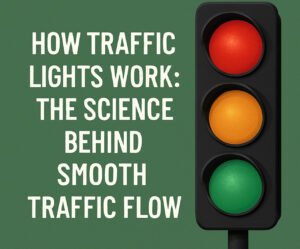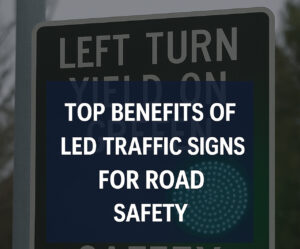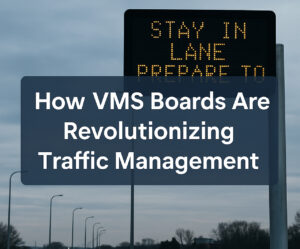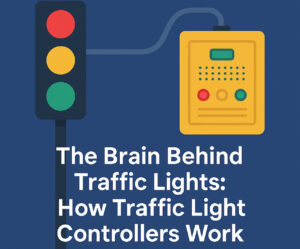As traffic technology continues to evolve, pedestrian crossing signs, no passing zone sign, and vehicle advertising magnets are no longer static fixtures on our roads. They’re becoming part of an interconnected, intelligent system thanks to the next generation of Variable Message Signs (VMS). These signs are shifting from passive warnings to dynamic communication tools, offering real-time updates, targeted messaging, and data-driven adaptability that will redefine road safety, traffic management, and even marketing. Know more..
What Are Variable Message Signs (VMS)?
Variable Message Signs are electronic signs typically placed along roadways to deliver important information to drivers. These may include warnings about traffic congestion, road closures, weather alerts, or other real-time conditions. But the future of VMS goes far beyond just displaying data—it’s about interaction, prediction, and personalization.
The Integration of Smart Technology
One of the most exciting trends in VMS is their integration with smart technology. AI and machine learning are now being used to process data from road sensors, GPS systems, and weather databases. This allows Variable Message Signs to deliver hyper-relevant information. For example, a sign could display “Slow Down – Rain Ahead” in real time or direct traffic around an accident just moments after it occurs.
Even pedestrian crossing signs are being enhanced with smart features. When a person is detected near a crosswalk, VMS can highlight the crossing more brightly or alert approaching vehicles via synchronized digital signs. This creates a safer environment in high-foot-traffic areas like school zones, shopping centers, or urban neighborhoods.
Mobility and Modular Designs
Modern VMS units are becoming increasingly modular and mobile. Governments and private contractors can deploy them rapidly at construction sites, during emergencies, or at events. These portable signs are often solar-powered and connected via cellular networks, allowing remote control and real-time updates. This means a no passing zone sign can now be activated dynamically, depending on road conditions or work zone schedules.
This mobility supports smart cities and connected infrastructure. When paired with IoT devices, VMS systems can become part of a holistic traffic control strategy that responds fluidly to real-time conditions.
Enhanced Customization for Communication
Customization is another critical development in Variable Message Signs. Messages can now be targeted not only by location and time but by vehicle type or user behavior. For instance, VMS can display tailored messages for commercial trucks versus passenger vehicles or issue school-specific alerts during certain hours.
And speaking of customization, vehicle advertising magnets are a surprising complement to VMS technology. In marketing-savvy cities, the same tech that powers personalized VMS could be used to synchronize with digital vehicle advertising, allowing fleets to adjust messaging based on geography or demographics. Imagine a food delivery vehicle driving through a college town displaying different promotions on its magnet than when it’s in a residential area.
Sustainability and Energy Efficiency
Energy efficiency is another major focus in the evolution of VMS. Solar-powered signs are becoming standard, especially for portable units. These setups drastically reduce emissions and operational costs. LED lights used in modern VMS are not only more visible in varied lighting conditions but also consume significantly less power.
The shift toward greener technology also aligns with larger governmental goals of reducing carbon emissions. As more infrastructure funding is tied to environmental benchmarks, we can expect an uptick in eco-friendly pedestrian crossing signs, no passing zone sign systems, and the entire VMS ecosystem.
Data Collection and Predictive Analytics
Future Variable Message Signs won’t just display data—they’ll gather it. Every interaction on the road is a data point: how many cars passed, at what speed, and in what weather. Machine learning models can then analyze this information to predict future traffic patterns or identify high-risk conditions before they occur.
This predictive capability will improve everything from emergency response times to everyday commute planning. It also allows VMS to do more than react—they can anticipate and prepare, offering a proactive approach to traffic control.
Enhanced User Engagement
New VMS will engage with drivers in more intuitive ways. Voice-assisted alerts, in-car displays, and integration with navigation apps like Google Maps or Waze will allow for seamless updates. A no passing zone sign could notify a driver’s app about a temporary restriction or hazard, prompting real-time navigation adjustments.
Pedestrian crossing signs can also connect with mobile apps, especially for people with disabilities. Imagine a visually impaired pedestrian receiving haptic feedback or an audible alert through their smartphone or smartwatch when it’s safe to cross.
Crisis and Emergency Use
Another key trend in Variable Message Signs is enhanced usage during emergencies. Whether it’s a wildfire, flood, or public safety threat, VMS will play an essential role in delivering life-saving instructions.
Geo-targeted messaging will allow officials to relay localized evacuation routes or warnings. These signs can adjust in real time, depending on how a situation unfolds. This capability could also help emergency responders by clearing traffic faster or rerouting vehicles.
Integration with Autonomous Vehicles
As self-driving vehicles become more common, VMS systems will be reimagined to communicate directly with autonomous navigation systems. These signs will send data to vehicles instead of just displaying it visually.
This is particularly relevant in scenarios involving vehicle advertising magnets, which are often mounted on autonomous delivery vehicles. These vehicles will rely heavily on real-time traffic data from VMS systems to navigate safely and efficiently.
The Blurring Line Between Static and Dynamic Signs
In the future, the distinction between static and dynamic signage will diminish. Standard pedestrian crossing signs or no passing zone sign will likely feature embedded lights or digital panels that adjust based on environmental and traffic conditions. This hybrid approach allows for consistent visibility and flexible functionality.
For example, during school hours, a pedestrian sign could become illuminated with flashing LEDs and even display live warnings like “Children Present.” Outside of those times, it reverts to a basic sign, conserving energy and reducing distraction.
Commercial Applications and Revenue Generation
Cities are also looking at VMS as a revenue source. By renting out space on digital signs for advertising during non-critical hours, municipalities can generate income. This creates a new layer of value, especially when combined with vehicle advertising magnets already being used by local businesses.
This synergy could see VMS used not only for safety but also as part of a city’s economic development and tourism strategies. Targeted advertising, public service announcements, and local event promotions can all be part of a well-integrated VMS network.
What to Expect Moving Forward
In summary, the next generation of Variable Message Signs is about smart adaptation. These aren’t just tools for traffic control—they’re platforms for communication, prediction, safety, and even commerce. We can expect:
- Real-time data-driven updates
- Dynamic no passing zone sign and pedestrian crossing signs
- Cross-device and in-app integration
- Environmentally sustainable designs
- Interconnected networks for cities, autonomous vehicles, and public services
The future will see VMS take on roles we’re only beginning to imagine—from improving pedestrian safety to synchronizing with vehicle advertising magnets for smart, mobile marketing.
One thing is clear: the days of passive signage are numbered. In their place, a smarter, more interactive, and more impactful system is emerging—shaping not only how we drive but how we communicate, navigate, and engage with our surroundings.





